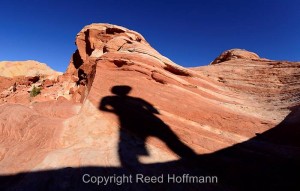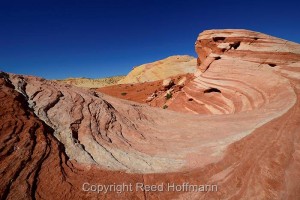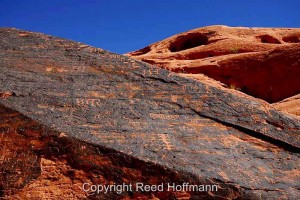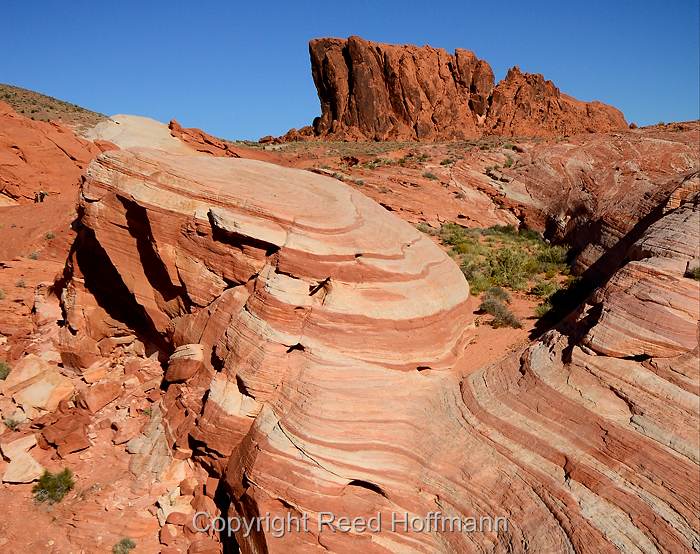I’ve had a love/hate relationship with Las Vegas for some time now. As a photographer, I love the strip at night – it’s well lit with great locations to shoot from and subjects to take pictures of, from the Eiffel Tower to the elevated crosswalks to the fountains at the Bellagio. But the excess also makes me think more than a little about the bible story of Sodom and Gomorrah…
About a week ago I was in Vegas to teach a workshop, and planned a little time before and after to get out of Vegas. I love the southwest for its open spaces, color and rock formations, and there are two great areas for that near Vegas – Red Rock and Valley of Fire. I’ve made it to Red Rock Canyon State Park a few times in the past, but had only one brief visit to Valley of Fire. So after landing in Las Vegas at 1am Friday morning, I was driving away from my hotel at 6:30am headed to Valley of Fire.

Another visitor made this picture for me, when he unintentionally stepped into my shot. Nikon D3200 set to white balance of Daylight and ISO of 200, shutter speed of 1/1250 at f/8, with exposure compensation at -1.0, lens at 10.5mm. Photo copyright Reed Hoffmann.
About an hour north and east of Las Vegas, Valley of Fire State Park is Nevada’s oldest state park, boasting not just great color and rocks but petrified logs and petroglyphs too. Prior to the trip I spent a little time reading about the park and looking at pictures on the web, and had picked a few areas I particularly wanted to see. At the top of my list was Fire Wave, a sandstone formation with great curving lines of color, rising up like a wave. Surprisingly, it’s not marked on the park map, but I found a blog post one man had written with directions on how to find it.
After parking at the pull-out, I found the trailhead across the road and made the half-mile hike in. After a few detours (tip, when you get to the area that leads out onto open rock, go RIGHT, not left), . I finally made it. Morning may not be the best time to photograph there (late afternoon would probably be best), but it’s still a beautiful location. Thinking it might look better as the sun got higher (better sidelight on part of the rock), I spent about two hours there. Not being a patient photographer, I used that time to explore, walking around the formation and also ranging out from it.

Fire Wave, shot from close and low with a 10-24mm lens. Nikon D3200 set to white balance of Dayight and ISO of 100, shutter speed of 1/250 at f/13, with exposure compensation at -0.7. Photo copyright Reed Hoffmann.
In the process of exploring, I’d worked my way all around the Wave. I always urge people, if possible, to look at their subject from every angle, low to high, and from every side. I did that here, getting under it and climbing a rock outcrop to see it from above too. During that process, as I was lying on the rock to get a band of shade in the foreground, another visitor stepped onto the ledge above me, throwing a shadow into my foreground. Not what I had planned, but better! Love it when that happens.
Eventually I decided that what made the Wave most interesting to me was the curving bands of color. So I decided to concentrate on that aspect, getting close with a very wide angle lens (10-24mm) to accentuate the curve.
To bring out as much color as possible, I changed the color processing on the camera (a Nikon D3200) setting Nikon’s Picture Control menu to “Vivid.” That boosts the contrast and saturation, to give more “punch” to the scene. And I underexposed a little as well (-.3 to -1), to make the colors a bit darker.
A lot of people might add a polarizing filter, and I tried that too. However, it created two problems for me. One, because of the wide angle lens, it created an inconsistent look to the sky, darker at one side and lighter at the other nearer the sun. And two, the sky was already a dark blue, and the polarizer made it darker still, verging on black. I’m a big fan of polariziing filters, but they don’t always help.

Petroglyphs on the walk in to Mouse’s Tank. Nikon D3200 set to white balance of Daylight and ISO of 200, shutter speed of 1/500 at f/10, with exposure compensation at -1.0, lens at 24mm. Photo copyright Reed Hoffmann.
By the time I got back to the car, I only had time for a couple of more quick stops before I had to get back to Vegas. I absolutely wanted to see some of the petroglyphs, dating back to around 1000 years old, so stopped by “Mouse’s Tank,” to take the short hike there. And on the way out I also went back to an arch I visited when entering the park, and boy was I glad I did. But that’s another story.
Las Vegas is a great weekend getaway, but not the way most people think of it. For photographers you can work the strip at night, and the nearby parks during the day. The biggest challenge will be finding time to sleep!

